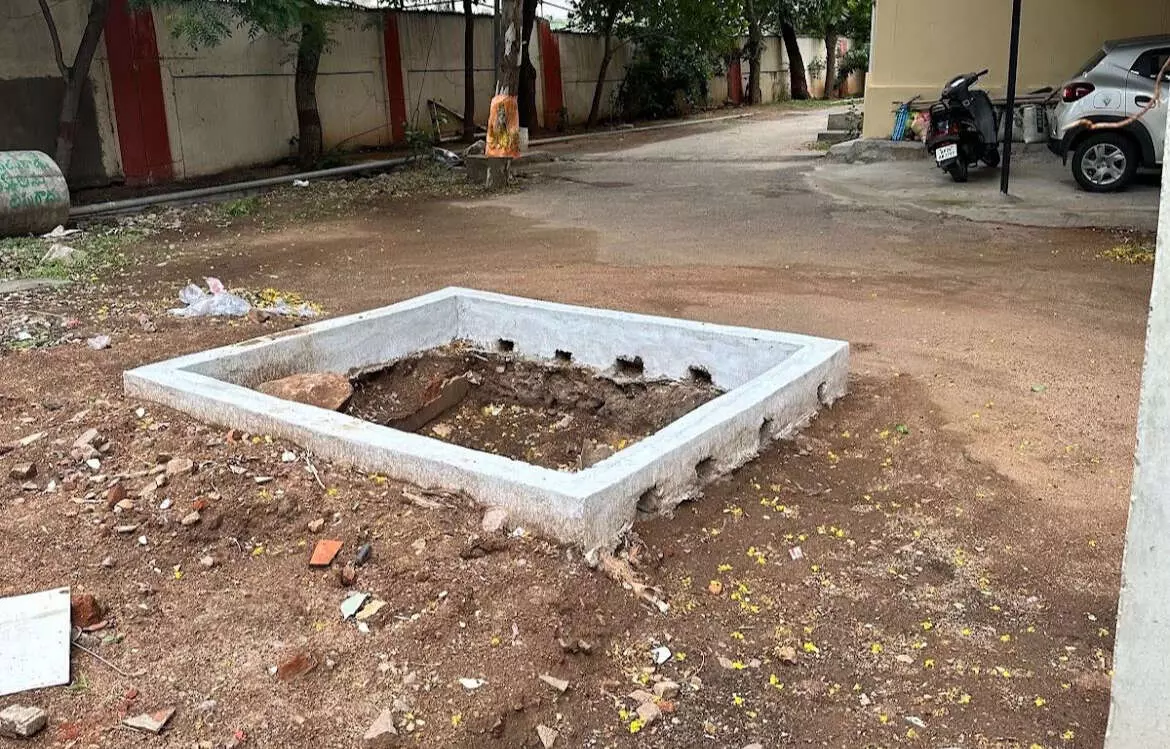Rainwater harvesting: Kundanbagh, Vayupuri set template for flood prevention in Hyderabad
ng. In these colonies, rainwater is collected through a network of RWH pits strategically placed around homes, parks, and streets
By Anoushka Caroline Williams
Hyderabad: Heavy rains led to widespread flooding in many parts of Hyderabad. However, certain colonies like Kundanbagh, Vayupuri, and others managed to stay dry, thanks to their well-implemented rainwater harvesting (RWH) system. These areas effectively prevented waterlogging and flooding while also boosting groundwater levels.
The Impact of Rainwater Harvesting in Hyderabad
Kundanbagh and Vayupuri are prime examples of how rainwater harvesting can mitigate flooding. In these colonies, rainwater is collected through a network of RWH pits strategically placed around homes, parks, and streets. These pits collect and store rainwater, channeling it underground to recharge local aquifers instead of letting it flow unchecked, which typically leads to flooding.
Ravi Kumar, a long-time resident of Vayupuri, shares, “In the past, our streets would often flood in just a few hours of rain. Since we installed the rainwater harvesting system, we’ve noticed a significant reduction in waterlogging. The water that would have previously caused flooding now replenishes our groundwater instead.”
Kalpana Ramesh, an architect and water conservation advocate, also highlights the benefits: “The RWH systems in these areas have significantly reduced the burden on drainage systems. Instead of water accumulating on the streets, it’s directed into the ground, ensuring that we contribute to groundwater recharge rather than urban flooding.”
How Rainwater Harvesting Works
Rainwater harvesting involves capturing runoff from rooftops, paved surfaces, and other catchment areas. This water is then filtered and directed into recharge pits or storage tanks. The collected water can be used directly or allowed to percolate into the ground, enhancing groundwater levels.
In Kundanbagh and Vayupuri, the RWH systems are designed to handle large volumes of water. The modular pits and trenches, equipped with filters, ensure that rainwater is free from contaminants before it seeps into the ground. These systems are compact and do not interfere with daily activities or infrastructure.
Suma Rao, a resident of Kundanbagh, says, “I was initially skeptical about whether rainwater harvesting would make a difference, but after seeing how well it worked during the recent downpour, I’m convinced. Not only did it prevent flooding, but it’s also reassuring to know that we’re doing our part to conserve water.”
Benefits of Rainwater Harvesting Pits
Prevents Flooding: As demonstrated in Kundanbagh and Vayupuri, RWH pits help manage large volumes of rainwater, preventing it from overwhelming stormwater drains and causing floods.
Boosts Groundwater Levels: By channeling rainwater into the ground, these pits help replenish local aquifers, ensuring a steady supply of groundwater even during dry spells.
Protects Infrastructure: Properly designed RWH systems prevent waterlogging, which can damage roads, buildings, and other infrastructure. In the colonies mentioned, there were no reports of water damage during the recent heavy rains.
Examples of Successful Rainwater Harvesting
The Rolling Hills gated community in Gachibowli is another success story. With 28 rainwater harvesting pits and 16 injection borewells, the community has not relied on water tankers for several years, even during severe summers.
Anil Sharma, a resident, reflects, “Our investment in rainwater harvesting has paid off. Not only have we reduced our dependency on external water sources, but we’ve also helped mitigate the flooding that used to be a regular occurrence in this area.”
Similarly, the rainwater harvesting efforts at Rashtrapathi Nilayam in Bolarum show how even areas with rocky terrain can benefit. By working with geologists and architects, effective solutions were implemented to capture and store rainwater, debunking the myth that rocky areas are unsuitable for RWH.
The Way Forward
The benefits seen in colonies like Kundanbagh, Vayupuri, and Rolling Hills underscore the importance of rainwater harvesting in urban planning.
As Rajesh Iyer, another resident of Vayupuri, notes, “We need more awareness about the effectiveness of rainwater harvesting. It’s not just about conserving water—it’s about protecting our homes and communities from the impacts of extreme weather.”
To encourage widespread adoption, the government and civic bodies should provide incentives and support for the installation of rainwater harvesting systems. Whether it’s retrofitting existing structures or incorporating RWH into new constructions, these efforts can go a long way in making Hyderabad flood-resilient.